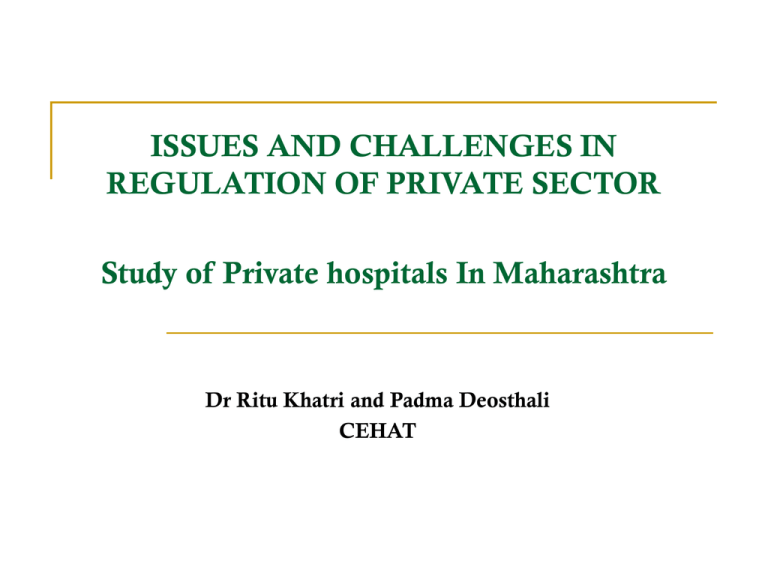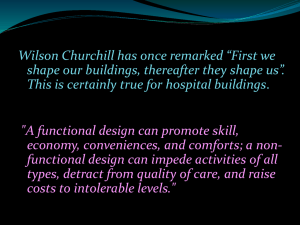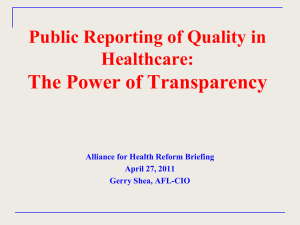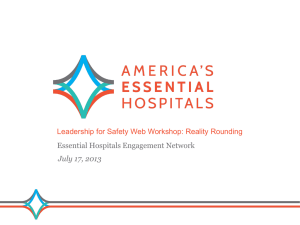ritu
advertisement

ISSUES AND CHALLENGES IN REGULATION OF PRIVATE SECTOR Study of Private hospitals In Maharashtra Dr Ritu Khatri and Padma Deosthali CEHAT Study in Maharashtra Objectives of the study: To assess the physical standards and quality of care provided by the private hospitals in Maharashtra To understand the problems and the concerns regarding the existing BNHRA and Accreditation among the hospital owners in Maharashtra. Sample and tools Sample: 261 hospitals upto 30 beds across 10 districts and Mumbai. Tools: Interview of facility In-Charge and Duty Medical Officer/Nurse Staff and Observation of the hospital were the methods of data collection. Semi-structured and open-ended questions were designed to collect information on the existing physical and clinical standards among the hospital, their awareness of the BNHRA Act, the issues, opinions and concerns regarding the implementation of the Act. Through the Observation Schedule, the availability and condition of mainly the physical aspects of care were assessed. Profile of the hospitals : 89.7% (234) of the owners of the hospitals are from the Allopathic system of medicine. Self proprietorship is dominant with 86.2 %( 225) of the hospitals owners being sole proprietors. 86.6 %( 226) of the hospitals are housed in self-owned buildings 40% (105) of the doctors said that they are involved in multiple facility practices Most of the hospitals are providing multiple services like maternity, surgical, medicine and other speciality. Human resources: 54% (141) of the hospitals do not have a DMO. Wherever present, they are mostly from other systems of medicine. One fourth of the hospitals do not have any qualified doctor to provide round the clock services. Neither the hospital in-charge is living in the hospital premises nor there is DMO available at the hospital The average no. of qualified nursing staff for each hospital is 1.68 nursing staff per hospital. Rest all were either untrained or trained in-house. Even additional services like laboratory and X ray are being provided by untrained staff. Standards of care: Emergency Services - 87%(228) hospitals reported that they provide emergency services but only 54.4%(124) hospitals provide round the clock services. 51%(117) of the hospitals have staff trained for emergency services. One hospital staff is trained for Cardio– pulmonary resuscitation. Availability of ambulance is 5%(13) and only 27%(70)of the hospitals had ICU. No functional plan followed among the hospitals. Basic facilities like telephone line, toilets, water supply, electricity supply and so on found to be satisfactory. Maintenance of records: Birth records 55% (143) and death records 69% (180) Standards of care (cont’d) Information given to the Patient Only 37.2 %( 97) of the hospitals provide information about the services available at the hospital. One fourth of the hospitals do not give IPD papers even on request, and half of them do not give OPD papers. About 9% do not give discharge papers. One fourth of the hospitals do not maintain a file for the patients. Privacy and Confidentiality to the Patients Nine hospitals (3.4 %) reported that they do not provide any type of privacy and stated that that there is no need to provide the same. About 6.1% (16) of the hospitals do not have any female present during the examination of female patients by male doctors. Standards of care (cont’d) Grievance redressal mechanism in Hospitals Nearly 61.7% (161) of the hospitals reported that they have some grievance handling mechanism. Fifteen hospitals had a designated person to look into the grievances of patients and these are large sized hospitals. About 80% (130) of the grievance handling mechanism is in the form of complaints registered with the doctor. There is no independent mechanism for handling grievances against the owner-doctor. Case of BNHRA (Bombay Nursing Home Regulation Act, 1949 First of it kind Registration of private nursing homes, to be renewed every three years. Still not implemented properly despite judicial intervention, civil society campaign. Applicable to the entire state. Non-compliance to minimum requirements under the BNHRA Display of registration number Only 21.4% of the registered hospitals displayed their registration number. Human resources: “Qualified doctor, qualified nurse and midwife in case of maternity home” Only 45% of the registered hospitals had a qualified DMO. The availability of qualified nurse in registered hospitals is 2 per hospital which is much below the actual requirements. Untrained nurses are present in registered as well as unregistered hospitals and form 10% of each. Of the 146 hospitals providing maternity services, only 11 had midwives. Registration and Maintenance of Birth and Death Records -In terms of maintenance of records, no difference was found between the hospitals that are registered and those not registered. Adherence to other laws/guidelines: BMW, PCPNDT and Emergency services are governed by separate laws. Adherence to these was found to be higher than to the minimum requirements for BNHRA registration. Violation of Universal Guidelines for Prevention of HIV/AIDS : 13% of hospitals indulge in compulsory testing for HIV, 50% conduct HIV test compulsorily for all operative patients and those seeking ANC. Emerging issues: Rapid Growth of Private Hospitals with less than 30 beds without any defined standards of care. BNHRA only provides minimum requirements for registration, other rules not yet implemented. Inadequacy of Human Resources, especially nurses. Issue of ‘in-house trained nurses” needs to be addressed. Need for better monitoring of registered facilities and stringent penalties for non compliance on an ongoing basis Absence of grievance redressal mechanism when doctors have asked for law for their own protection! Bringing all Laws governing Private Hospitals under one umbrella to ensure better implementation. THANK YOU !





